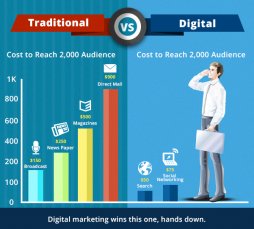[UPDATE 1/21/2015: This post, originally written several years ago, has been updated twice—including today—in order to remain relevant. It is one of the most popular posts ever published on this blog. I hope you find it helpful. –P.R.]
Before we delve into the nitty-gritty of costs vs. returns and swim in the sea of numbers, let’s start with this premise: Marketing is a necessity. We can all agree here, right? The reason I want to state this upfront is because too often the debate about costs veers into an accounting debate about what numbers are justifying marketing. Don’t get me wrong, I love accountants as much as the next guy (cue shout-out to Fathom accounting staff), but when marketers start talking like accountants, they sometimes lose their grip on reality. And while we should be experimental and innovative, we should always keep our feet firmly grounded in reality as marketers, which sometimes means ignoring the numbers.
Now, on to the numbers …
Contrary to what you might think, public pricing estimates for SEO and inbound marketing are not hard to come by. Outsourced online marketing costs typically fall into a range based on time of a contractual engagement and size of the client and its needs, but can also be linked to individual projects (which are generally broken down into hours and corresponding billable rates, explicitly or implicitly). Data from a December 2011 SEOmoz survey of agencies and consultants across 6 international regions show, for example:
- Hourly rate: $76–$200/hr.
- Project-specific pricing: $1, 000–$7, 500
- Monthly retainers have a wider distribution than hourly rates/projects
- 2 most common monthly retainer cost ranges: $251-$500/month (13.8%); $2, 501-$5, 000/month (11.3%)
[Full disclosure: In order to maximize returns for its clients, Fathom operates primarily on long-term contracts renewed annually. Pricing is highly custom—therefore variable—but today’s typical engagement starts at $10K per month. Separate hours-based projects may also be considered on a case-by-case basis. See the full list of services.]
Cost vs. Return
OK, so now you know a little about online marketing costs, but the discussion would be incomplete without putting those costs in a context of return value. To do this, let’s reframe the question as “What (return) does digital marketing give me for the cost?” Does your boss or company execs view digital marketing purely as a cost center (an ‘escalator of costs, ’ as the PR 20/20 2014 Marketing Score Report indicates)? If this is the case, as John Twohig aptly notes, you need to preach some Peter Drucker to the skeptics:
“Because its purpose is to create a customer, your business has two purposes and two purposes only: Marketing and innovation. Marketing and innovation make you money, generate sales, produce profit. Everything else is an expense …”
–Peter Drucker
Think your head of sales still won’t buy this? Point her to Fathom’s chief revenue officer, Jeff L. Herrman—a longtime sales guy (and marketing skeptic-turned-evangelist)—who provides an answer from the born-again “cost center” club.
How, exactly, do you know if marketing is, in fact, ‘making you money?’ One big benefit of Internet-based marketing (vs. traditional forms) is that actual audience behavior tends to be easier to track and measure. Case-in-point: Let’s look at one simple example involving video.
Tracking traditional media: Video
In the traditional ad world, you might have a general idea of how many viewers saw your slick (and expensive) 30-second TV commercial during the 11:00 p.m. syndicated X-Files rerun, but knowing how many of those people actually were moved to check out your product/service as a result is a much trickier act.
As a result, the notion of marketing ROI has traditionally been somewhat abstract or simply reduced to a “brand exposure/popularity” model: A publication—TV show, magazine, newspaper, billboard—gets x many viewers of a certain demographic, and the advertiser estimates this exposure is valuable because some percentage of that sizable demographic is receptive to and will theoretically be influenced by the ad. Or, you simply know that your competitors are advertising in those places, so you do it to ‘keep up with the Joneses’ (er, Johnson & Johnson’s).












